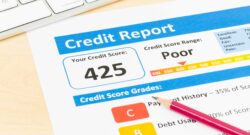Author: Regan Hagestad
A Check-up On Our Industry
This month I suffered a sinus infection, which seems to be a staple of fall for many. Interestingly, I knew it was coming. I could feel the signs of its onset prior to experiencing the full symptoms. The real estate and mortgage industries are in similar positions – feeling as though something is coming, but unsure of the exact nature and severity of the illness in store. Let’s head to the doctor for a check-up in this week’s Three Things to Know. The ‘Itchy Throat’ Data Logan Mohtashami, one of Housing Wire’s lead analysts, published a piece last week so full of juicy data I spent almost an hour digesting it. It looks like we’ll enter 2023 with historically low inventory. Offers on existing homes have fallen drastically, and days on market have increased to more than one month in most local markets. Despite this, home prices seem to be holding on stubbornly to the gains made in the past two years. Anecdotally, I’m seeing builder ads offering $30,000 or more in incentives, a signal they are feeling the slowdown. Fed chair Jerome Powell asserted his desire to see a housing correction in a recent press conference, so we can only wonder if we are entering the early stages of a drawn-out lull. Mortgage Closures Endemic, But Don’t Panic Yet In July of this year, I published a piece warning of a coming washout in the mortgage industry. A quick check of the list of mortgage layoffs, merges, and closures reveals the wave I predicted has occurred. I still caution against overreaction and believe this is simply our industry making a U-turn. Banks, lenders, and brokers amassed staff and salespeople for years as demand for mortgage grew, and this dramatic downturn in real estate has forced our companies to make painful decisions. Those decisions, which currently look like trouble in the industry, will make us sustainable in the event this downturn is prolonged. A New (or Old) Tool to Tackle Disease In order to confront the challenge of qualifying home buyers in a high-rate environment, lenders are pulling a dusty product off the shelf. The 2-1 Buydown, almost forgotten until recently, is becoming a hot commodity. Agents ought to familiarize themselves with this powerful tool that can bring buyers off the bench and help them afford more payment. This product is the opposite of adjustable-rate mortgages, where a low-rate stays fixed for years, then adjusts. A 2-1 buydown offers a rate that is two percent lower than current rates for year one, one percent higher in year two, then full market rate in year three. Example: If current rate is seven percent, the client will receive a five percent in year one, six percent in year two, and seven percent the remaining years. The obvious gamble is that rates will drop in the next two years, creating an opportunity for a refinance. There’s a substantial cost, usually more than two percent in closing costs, but many lenders require sellers to cover the fee. Offering this, as a seller, can be an efficient way of attracting buyers to a listing.
6 Ways to Get a Good Mortgage Rate
We all know that buying a home is one of the most significant purchases you’ll ever make, and since most people don’t have ample liquid cash available, a good mortgage rate is a necessary part of the process. That being said, the terms of your mortgage matter greatly, since the interest rate, type of mortgage and length of time you have to repay can dramatically impact the total amount you spend. If you lower your rate by a percentage point or two, or pay off the mortgage a few years early, you can save thousands in interest during the course of the loan. Here, Bankrate explains some ways you can ace the mortgage application process and get the best possible mortgage rate. 1. Improve your FICO credit score Your three-digit credit score can be the difference between getting a low rate or costly borrowing terms. A credit score is an important factor when it comes to determining a borrower’s risk, with your lender using the score as a benchmark in deciding whether you will be able to repay the debt. In other words, the higher the score, the higher the likelihood that the borrower will not default. In general, the more confident the lender is in your ability to repay your loan on time, the lower the interest rate they’ll offer. To improve your score, pay your bills on time and pay down or eliminate credit card balances. If you must carry a balance, make sure it’s no more than 20 percent to 30 percent of your available credit limit. Also, check your credit score regularly and look for any mistakes. If you find any errors, work to clean them up before applying for a mortgage. 2. Build a record of employment You will be far more attractive to your lender if you are able to show at least two years of steady employment and earnings, especially from the same employer, so be prepared to hand over pay stubs and W-2s. Note: If you’re self-employed or your pay is coming from multiple part-time jobs, it can be more difficult to qualify. 3. Save up for a down payment Putting down more money can help you obtain a lower mortgage rate, particularly if you have enough liquid cash to fund a 20 percent down payment. Of course, lenders accept lower down payments, but less than 20 percent usually means you’ll have to pay private mortgage insurance (or PMI), which can range from .05 percent to 1 percent of the original loan amount annually. The quicker you can pay down your mortgage to less than 80 percent of the total value of your home, the sooner you can eliminate mortgage insurance and reduce your monthly bill. 4. Consider an adjustable-rate mortgage While taking out a traditional 30-year fixed-rate mortgage might not make financial sense for all homebuyers, it might save you money if you lock in a lower rate for a shorter period of time, such as five, seven or 10 years. An adjustable-rate mortgage (ARM) is an option to consider, although you need to be aware that the interest rate could increase after the fixed period ends and the rate readjusts. Buyers typically choose a term from three to 10 years, depending on their needs. For example, a first-time buyer who hopes to get a job promotion in five years and move or upsize to a more expensive house can save a little money while they’re there because the ARM loans should be at a better rate than the 30-year fixed. 5. Choose a 15-year fixed-rate mortgage If you think you’ve found your long-term home and have good cash flow, you likely will want to consider a 15-year fixed-rate mortgage so you can pay off your house sooner. According to U.S. Bank, the national average for a 15-year mortgage is 4.15 percent. On a $260,000 loan, your monthly payments will be considerably higher ($1,943 vs. $1,264 for a 30-year fixed), but you’ll save more than $100,000 in interest during the life of your loan. 6. Lock in your rate Sometimes the closing process can take weeks or even months, during which time rates can fluctuate. Once you sign the home purchase agreement and secure your loan, ask your lender to lock in your rate. The service sometimes comes with a fee, but it might pay for itself if rates rise.
Homebuyer Checklist: 4 Ways to Overcome Financial Obstacles
The purchase process can be complicated for potential homebuyers with challenging financial situations—including large student debt, a divorce or bankruptcy, medical issues, job loss, a new job or even relocation—and that can often lead to buyer hesitancy. Here, RISMedia examines financial hurdles some buyers might face and how they can work to overcome them. Homebuyer Checklist #1: Lender rejection Your credit score plays the biggest role in determining what types of loans you will be eligible for, so the first thing you need to do is get your finances in order. Obtain copies of your credit reports and have any errors corrected. If you have a lot of credit card debt, work to pay down the balances and lower your debt-to-income ratio. Also take a hard look at your budget and write down all of your monthly expenses, and then look at your monthly income after taxes to determine how much you can afford for a mortgage without stretching yourself too thin. Homebuyer Checklist #2: Coming up with a down payment While some first-time buyers are able to score down payment rates of as little as 3.5 to 5 percent, most are expected to save at least 20 percent, which can be difficult, especially in places where the cost of living is high. In those cases, buyers may need several years in those cases to save the amount. To increase the pace, consider setting up an automatic savings program, cutting expenses, or borrowing from relatives or a retirement account. Homebuyer Checklist #3: Obtaining a minimum FICO Score Most lenders use a FICO Score to determine your credit risk. To arrive at its scores, FICO examines how often consumers pay their bills on time, the percentage of available credit they’re using, the average age of their lines of credit, their total number of accounts, derogatory marks in their credit report and other related factors. Scores range between 300 and 850—the higher the score, the lower the risk. You can get your score online through several free or paid apps, but your lender usually can provide the most accurate score by pulling the numbers from the big three reporting agencies and using the middle number from each. Knowing your credit score is a good way for both you and your lender to start out the buying process on the same page in terms of what home price range might be available to you. Homebuyer Checklist #4: Considering cost of living If you’re thinking about moving to a new area, one of the biggest considerations should be understanding any additional costs you may have in your new location. Cities come with different price tags. For example, housing prices in the downtown of a large city will be far more than in a small town. Make sure you know what you’ll be spending before you commit. Even grocery prices tend to change. The worst thing that could happen is you move and find out you can’t afford your new city.
4 Factors That Can Help You Buy a Home When You Have a Less-Than-Perfect Credit Score
While your credit score is an important factor in being approved for a loan, other factors also are involved when it comes to determining your ability to afford to buy a home. If your credit score leaves something to be desired, Forbes suggests looking at these four factors that can help to achieve your dream of becoming a homeowner. 1. Debt-to-income ratio Lenders examine your debt-to-income ratio (DTI) when deciding whether or not to approve you for a loan. This ratio is the sum of all your monthly debt payments (including credit card debt, car payments, student loans, etc.) divided by your total monthly income, and lenders typically look for a ratio of 50 percent or less. First, you’ll want to determine your current ratio by adding up all your debts and then dividing the total by the sum of all your monthly income streams. If your ratio is higher than you’d like it to be, there are two options to improve it: generating more income through a second job or allocating more of your current income to pay down your debts. Before you begin deciding how to tackle your DTI, however, your best bet is to talk to your lender. He or she will be able to look at the particulars of your financials to help you zero in on the money moves that will make the greatest impact. 2. Down payment Buying with bad credit often means looking for ways to reassure the lender that you’re a risk worth taking by proving you’re capable of paying back the money you’re borrowing. One way to do that is by bringing a larger-than-normal down payment to the table. While most loans only require you to put down 3-5 percent, you should aim to have a down payment of at least 10 percent. This reassures lenders for two reasons: It shows you have the ability to save large sums of money, which often indicates financial responsibility, and reduces the overall amount of funds you need to borrow. The result? Lenders view you as less of a risk. 3. Loan options Individuals with less-than-perfect credit can find loan options that specifically cater to those with a lower score. Your lender may know of additional options that are unique to your area, the most common ones are: FHA Loans Guaranteed by the Federal Housing Administration If you have a score of 580 or higher, you qualify to put down as little as 3.5 percent If you have a score of 500-580, you still can qualify for the loan, but you need to put down at least 10 percent You need to pay mortgage insurance over the life of the loan VA Loans You must have performed military service or be a military spouse to be eligible You can finance up to 100 percent of the property’s value There is no minimum credit score requirement—it’s up to the individual lender to decide This loan does not require mortgage insurance 4. Family and friends Buying with bad credit often comes down to asking for a little help from family or close friends. Here are two ways that they can assist you in your goal of becoming a homeowner: Consider using gift money Maybe your parents are financially capable of and generous enough to be able to help you with your down payment, or maybe your grandparents have been putting money aside for you since you were born. Either way, it is possible to use funds given to you to purchase a home. This is known as receiving gift money. Before you can accept any funds, however, talk to a lender to get help documenting the transfer of funds so they aren’t called into question during the underwriting process. Get a co-signer If you’re truly unable to qualify for a loan on your own, you may be able to do so with the help of a co-signer. A co-signer is someone (usually a primary family member) who has good financial standing and can provide some peace of mind to the lender. The co-signer essentially agrees to take care of the loan if you stop paying or are unable to continue making payments.
A Guide to Why Mortgage Interest Rates Go Down and Up, and What to Do
Whether you’re seeking a home loan for your first house or your fifth, you still are probably wondering what does “interest rate” even mean? Why do rates swing up and down? And, most importantly, how do you get the best interest rate—the one that’s going to save you the most money during the life of your mortgage? Here, realtor.com outlines what you need to know about interest rates before applying for a mortgage, and as always, your loan officer is always on hand to help answer any questions that might arise. Why does my interest rate matter? Interest is the extra fee you pay your lender for loaning you the cash you need to buy a home. Your interest payment is calculated as a percentage of your total loan amount. For example, if you get a 30-year, $200,000 loan with a 4 percent interest rate, you would end up paying back not only that $200,000, but an extra $143,739 in interest in 30 years. Month to month, your mortgage payments would amount to about $955. However, your mortgage payments will end up higher or lower depending on the interest rate you get. Why do interest rates fluctuate? Mortgage rates can change daily depending on how the U.S. economy is performing. Consumer confidence, reports on employment, fluctuations in home sales and other economic factors all influence interest rates. During a period of less economic activity, the Federal Reserve will provide more funding and interest rates will decrease. Conversely, when the economy heats up and there’s a fear of inflation, the Fed will restrict funding and interest rates will increase. How do I lock in my interest rate? A rate lock is a commitment by a lender to give you a home loan at a specific interest rate, as long as you close on your home in a certain period of time—typically 30 days from when you’re pre-approved for your loan. A rate lock offers protection against fluctuating interest rates and offers borrowers peace of mind. No matter how wildly interest rates fluctuate, once you’re locked in you know what monthly mortgage payments you’ll need to make on your home, enabling you to plan your long-term finances. Many home buyers obsess over the best time to lock in a mortgage rate because they’re worried that they’ll pull the trigger right before rates sink even lower. Unfortunately, no lender has a crystal ball that shows where mortgage rates are going. A bigger question to consider when locking in your interest rate is where you are in the process of finding a home. Most mortgage experts suggest locking in a rate once you’re under contract on a home—meaning you’ve made an offer that’s been accepted. Most lenders will offer a 30-day rate lock at no charge to you—and many will extend rate locks to 45 days as a courtesy to keep your business. Some lenders offer rate locks with a float-down option that allows you to get a lower interest rate if rates decrease. However, the terms, conditions, and costs of this option vary from lender to lender. How do I get the best interest rate? Mortgage rates vary depending on a borrower’s personal finances. Specifically, these six key factors will affect the rate for which you qualify: Credit score: Lenders use your credit score to predict how reliable you’ll be in paying your home loan. A perfect credit score is 850, a good score is from 700 to 759, and a fair score is from 650 to 699. Generally, borrowers with higher credit scores receive lower interest rates than borrowers with lower credit scores. Loan amount and down payment: If you’re willing and able to make a large down payment on a home, lenders assume less risk and will offer you a better rate. If you don’t have enough money to put down 20 percent on your mortgage, you’ll probably have to pay private mortgage insurance, or PMI, an extra monthly fee meant to lessen the risk to the lender that you might default on your loan. PMI ranges from about 0.3 percent to 1.15 percent of your home loan. Home location: The strength of your local housing market can drive interest rates up or down. Loan type: Your rate will depend on the type of loan you choose. The most common type is a conventional mortgage, aimed at borrowers who have well-established credit, solid assets, and steady income. If your finances aren’t in
5 Money Mistakes That Can Get Your Mortgage Denied
You’ve been pre-approved for a mortgage, found the perfect home and had your offer accepted. All you need to do now is sit back and wait for closing, right? Well, not exactly. While the odds are reasonably good that nothing major will go wrong, that doesn’t mean things can’t go wrong. A financial misstep now could change your mortgage terms and interest rate, or even get you denied altogether—even if you have a closing date on the books. To make sure that doesn’t happen, realtor.com suggests that you avoid these less-than-savvy money moves. 1. Moving money around If you’ve been storing up cash reserves, do not move that money out of savings and into stocks while you wait to close. Although you might like to make some extra cash off those reserves, remember that it’s showing your liquidity. Moving money around can cause problems with your loan approval because lenders are counting how much money you have going into closing. With savings, lenders count that as 100 percent, but with stocks, they only use 70 percent of the value because stock prices can change. So, if you have $100,000 in savings and you move that into stocks, suddenly you only have $70,000 from an underwriter’s perspective. You’ll need enough cash to cover the down payment, closing costs and at least three months of mortgage payments. If the stock deduction dips your assets too low, you could be looking at a denial. 2. Taking a leave of absence from work Lenders rely on you being willing and able to work after they approve your loan because it’s the only way to prove you’ll make those monthly payments. Things can happen, and sometimes you might have to take a leave of absence, but don’t risk it unless it’s completely necessary—or unless you’re prepared for your mortgage to get delayed or denied. If you take a medical leave right before closing, for example, you might have to wait for two more paychecks to prove you’re back at work. 3. Applying for new lines of credit Applying for a new credit card or requesting a credit limit increase a few months before closing probably won’t harm you too much. But don’t let the credit inquiries mount. Worse than the actual hit on your credit score is any pattern of trying to borrow more money from more companies all at once. This suggests you are not wise with your money and just out running up debt you may not be able to repay. Rather than trying to determine how many credit inquiries is too many, or how much new credit you can take on without getting your mortgage denied, leave the applications alone until you’re through closing. 4. Going on shopping sprees Buying a new home is exciting, and you’ll probably want to go out and buy new furniture and appliances. But don’t get too carried away. Lenders often run credit reports within hours of the scheduled closing, so running up new large debt is a bad idea. It can change debt ratios, change your interest rate, and even lead to a lender deciding you have too much debt and you’re not worth the risk anymore. 5. Taking a new job—even a better-paying one Getting a new job halfway through the home-buying process disrupts an already tedious paperwork process. That said, some moves are more OK than others—like getting a promotion within your company or even making a lateral move to another. Lenders are less OK if you switch fields. Even with a potential pay increase, that kind of switch is seen as too risky to mortgage lenders because you don’t have a proven track record of being able to work in the new field. Lenders want to feel secure knowing that you can repay the loan. Making changes—particularly to your primary source of income—isn’t seen as stable as remaining in a job long term. Even if you do remain in the same industry, you should beware of switching into a role where your income is largely dependent upon bonuses or commissions—even if your annual income will end up being higher than your current position. Lenders can’t see what you haven’t earned yet, and they’ll factor that into your mortgage approval.
Can I Refinance While Buying a Second Home?
Say you’ve found a property that will be a great investment at a bargain price. Or perhaps the beach cottage you’ve had your eye on for years just came on the market. Whatever the reason, if you’re considering applying for another loan while refinancing your current home, the process can be somewhat complicated. To give you the full picture, Realtor.com breaks down the rules. Ensure you will qualify for the new home loan There’s nothing wrong with refinancing one mortgage at the same time that you are buying an investment property or second home with a mortgage. The key factor to making both the refinance and new purchase work is to ensure you will qualify for the new home loan. This means taking into account your current home payment. Your lender can very easily tell you the total payments and loan amounts you’ll be able to carry based on your current income. In some cases, you may even have to refinance to reduce your current mortgage payment to qualify for the new loan. Or you may need to cash out funds from the refinance to come up with the down payment on the new property. The only ironclad rule is that you can’t refinance a primary residence while applying for a mortgage on a new primary residence. Consider working with one lender for both mortgages The benefit of doing both loans—refinancing and obtaining a new mortgage—is that you can deal with a single loan officer and provide most of your documents (tax returns, W-2s, pay stubs, bank statements, etc.) only once. You also can optimize your loan balances and your monthly payment to a degree by doing both loans with the same lender. When refinancing and buying at the same time isn’t a good idea You shouldn’t refinance a home you intend to sell in the next six months or so because it’s not cost-efficient. The closing costs don’t vary because you intend to pay off your loan in a short period of time. Additionally, most refinances have a clause stating the borrower must stay in the home for at least one year. This means you cannot refinance a primary residence, close on a second home and then immediately move into it permanently. The differences between an investment and second home When applying for your second mortgage, your lender will take into account how you plan to use the property. So, it makes a difference if the second home is for investment purposes or is a vacation home for personal use. If the home is an investment, you can use proposed rental income as an add-on to your second income when qualifying for the second mortgage. But if you’re purchasing a vacation home, the new debt will count 100 percent against your current income, and that could prevent you from qualifying for a refinance and a second mortgage. The good news for those looking to buy a beach cottage or winter retreat? Vacation home mortgage rates typically are lower than investment home rates. You also can typically put down less cash——sometimes just 10 percent.
Did You Get All Your 2019 Home Tax Deductions?
In the wake of all the changes ushered in by the new tax plan, the Tax Cuts and Jobs Act, realtor.com offers a list of all the tax breaks for homeowners. Mortgage interest In the past, you could deduct the interest from up to $1 million in mortgage debt (or $500,000 if you filed singly). But for loans taken out from Dec. 15, 2017, onward, only the interest on the first $750,000 of mortgage debt is deductible. Mortgages are structured so that you start off paying more interest than principal. For example, in the first year of a $300,000, 30-year loan at a fixed 4 percent interest rate, you’d be deducting $10,920. Note: Taking this deduction under the new tax law does require itemizing deductions, but it may be worth the trouble, especially for new homeowners. Mortgage points If you bought a home and paid points, then you can still deduct those from your taxes. They must be “true,” or discount, points, rather than origination points. After all, points are essentially mortgage interest that you prepay, so it makes sense that they’d be treated like the rest of your mortgage interest. Each point is 1 percent of the loan amount, so if you paid 2 points on a $300,000 loan, you can deduct $6,000. Private mortgage insurance If you can’t make a 20 percent down payment on your home, most lenders require that you pay private mortgage insurance or PMI. The upside: It’s tax-deductible, as long as your adjusted gross income is less than $100,000. (For each $1,000 you make after that, you can deduct 10 percent less of your PMI, up to $109,000.) PMI is generally between 0.3 percent and 1.5 percent of the loan amount annually, so on a $300,000 loan, you’d be deducting between and $900 and $4,500. Home equity debt interest Homeowners often take out a home equity loan or home equity line of credit to tap into some quick cash—for college, weddings, home improvements or otherwise—using their home as collateral. And up until 2017, homeowners could deduct the interest on home equity debts up to $100,000 for married joint filers. Now home equity debt interest deductions have been eliminated unless you spend the money on home improvements. And unlike mortgage interest deductions, the new rules on home equity debt apply to all loans regardless of when they were taken. To reap the benefit, your total debt—meaning your mortgage, plus your home equity loan—can’t be more than the new $750,000 cap. Property taxes This tax season, there’s a $10,000 cap on the combined amount of your property taxes, state and local income taxes, and (for states without income tax) deductible sales tax. One bright side for landlords and those with vacation homes: You can take deductions for all the properties you own, plus add your state income tax. Energy-efficient upgrades Did you add solar panels or a solar-powered water heater last year? That means you can help yourself to a tax credit. Qualifying solar electric panels and solar water heaters are good for a credit of 30 percent, plus the cost of the equipment and installation. For a $30,000 green investment, that’s a cool $9,000 back. To qualify, the solar panels have to generate at least half of the energy used by the home, they have to be installed in your primary residence, and they can’t be used to heat a pool or hot tub. The credit will remain 30 percent of the cost for equipment installed between now until the end of 2019, 26 percent until the end of 2020 and 22 percent until the end of 2021. Home office deduction The home office tax deduction disappeared for all W-2 employees who have an office elsewhere that they could use if they wanted to. The only people who can continue taking this deduction are those who truly run their own business from home. Using the simplified home office deduction, self-employed people can take $5 for every square foot of office space, up to a maximum of 300 square feet. For a 200-square-foot home office, you’re looking at a nice $1,000 deduction. It must be a dedicated home office, used only for work
- 1
- 2










